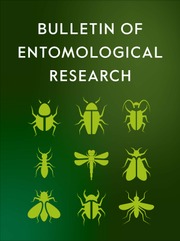Article contents
Isolation and characterization of the first microsatellite markers for the southern harvester termite, Microhodotermes viator
Published online by Cambridge University Press: 10 May 2016
Abstract
The southern harvester termite, Microhodotermes viator, is ecologically important due to its nutrient cycling activities and trophic interactions. Additionally, M. viator appears to have very long-lived colonies, which amplifies their effect on the environment. In order to estimate the longevity of a colony it is necessary to understand colony genetic structure. However, intra- and intercolonial genetic structure and levels of relatedness have not yet been examined in this species, likely due to a lack of microsatellite markers that effectively hybridize in this species. Here we describe the identification and characterization of seven microsatellite loci for M. viator, using an enriched approach and a preliminary test of their suitability for studies of fine-scale population genetic structure. Seven polymorphic loci were identified, none of which deviated from Hardy–Weinberg equilibrium. The loci had an average of 5.8 alleles per locus (range: 2–14) and an overall mean heterozygosity of 0.51 ± 0.3. Across all loci, population level pairwise F ST values showed significant genetic differentiation. The loci described and preliminary genetic data presented here provide an invaluable tool for future studies of population structure and longevity in M. viator colonies.
Information
- Type
- Research Papers
- Information
- Copyright
- Copyright © Cambridge University Press 2016
References
- 1
- Cited by


